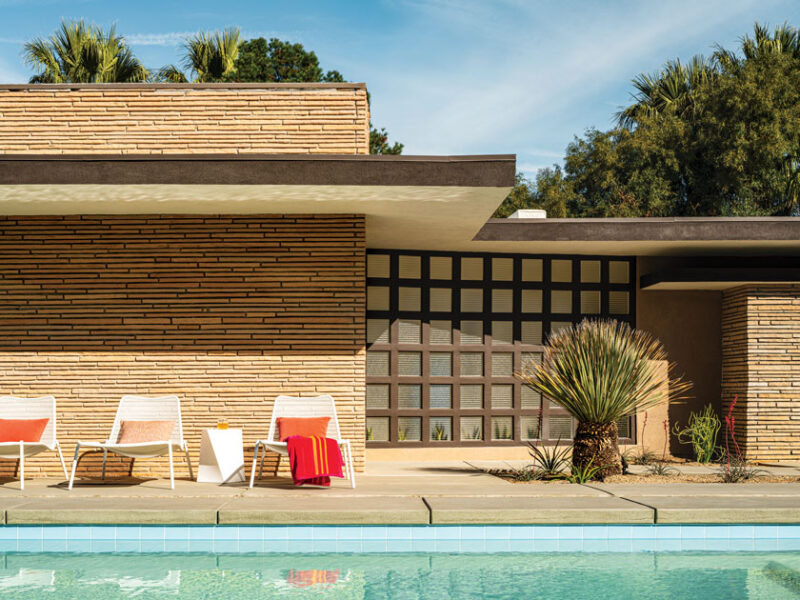A restoration and renovation company teams up with an architectural historian to save a 1948 Herbert Burns residence from being stripped of all its character.
We recognize as a hero someone who demonstrates courage and saves the day. You could say that partners Jackie Thomas and DeeAnn McCoy, owners of Thomboy Properties, became heroes when they saved a 1948 Herbert Burns residence from demolition. After the house was nearly stripped of every signature architectural feature, Jackie and DeeAnn purchased the property and planned not only to renovate it, but also to restore the home to its past beauty. They consulted Herbert Burns historian Steven Keylon along the way.



Originally built for Dr. George Gillman and his wife, Sadie, this Palm Springs home was in the process of being completely gutted by a group of investors—who didn’t appreciate the treasure they had purchased—when they ran out of money, and Thomboy Properties swooped in to save the day. “We got an email from a real estate agent wanting to know if we’d be interested in this property,” says Jackie. “It was down to the studs, but it spoke to us.”
The sandstone slab lines the entire entryway, inside and out. This hallway was narrow in the original footprint, so they reframed the bedrooms to make the hallway wider by a foot. The team found traces of the original front door paint, so they attempted to get as close as possible to those colors. A unique original feature is the indoor planter next to the glass grid.
Respect and Reimagine
To say restoring and renovating the 1948 Herbert Burns home was a lot of work is an understatement, but this wasn’t Jackie and DeeAnn’s first renovation. They both left corporate jobs in 2010 to renovate Mid Century Modern homes in Palm Springs, and they’ve been living their dream ever since. “Our goal is to respect the beauty and simplicity of design from the past and reimagine it for the way people live today,” says Jackie.



They determined this residence was one of architect Herbert Burns’ most lavish homes. It most likely sold in the 1970s or ’80s, and the new owners added a small guest house that became part of the renovation. But to ensure they were getting the details right, Jackie and DeeAnn had to procure reliable resources.
Photos from the Past
The only photo documentation of the home in its original state was the feature in the 1951 issue of the Los Angeles Times Home magazine. However, the images were blurry, so they decided to consult with an expert: architectural historian Steven Keylon, author of The Design of Herbert W. Burns. “We texted him asking if he knew anything about the property, and he called us as soon as we hit Send,” says Jackie. “He was our silent partner on this project.” To learn more about Herbert Burns and Steven’s book, click here.



You can catch a glimpse of the green Weldtex wall to the right of the vintage-inspired yellow chairs. “Thanks to Steven Keylon we were able to connect with Jeff [Nichols] at Eichler Siding in Northern California. He even came to [Modernism Week] with his wife to see the finished product,” Jackie says.
Being an expert on Burns, Steven was more than familiar with his architectural style and had kept an eye on this property ever since he moved to his own Palm Springs Burns residence in 2016. “I had taken a lot of pictures in the first phase where it wasn’t gutted,” he says. “They were also able to measure details in my house to compare.” Armed with Steven’s photos, the grainy magazine images and some pictures the Burns’ family gave to Steven during his book interviews, they set to work on the extensive renovations.
Signature Look
The goal was to reintroduce Burns’ signatures. “There were little details missing that had to be replicated,” says Steven. Arizona sandstone columns and walls, a rib glass wall, a floating soffit, the pool and the secondary roofline were the most important items on that list.




The challenge then became resourcing the outdated materials, such as sandstone and Weldtex (a striated or combed accent wood panel), but they were able to source original Burns materials where they could and replicate them where they couldn’t. “Burns used redwood from the early 1940s as slats in the ceiling, and we were able to fill in the holes,” says Jackie.

When they found the glass wall visible from the exterior and from the interior entryway, the horizontal slats had been removed along with all the glass. There are 66 panes in total, and only 25 panes had the same dimensions. To get the glass inserts correct, they had to individually measure each square, since most of them varied slightly in size. “The juxtaposition of horizontal planes and vertical details makes his architecture interesting,” says architectural historian and Herbert Burns expert Steven Keylon.
A Historic Future for the 1948 Herbert Burns Home
Now, the home represents the best of Mid Century Modern style with updates for modern living.
“It’s the best example of Desert Moderne from the 1940s,” says Jackie. “It takes advantage of the natural desert beauty and outside living.”

From the start of the project, they made it their goal to have the restoration completed by Modernism Week 2020 so it could be a showcase home, and they succeeded. “Now we want to pursue a nomination to make it a Class 1 Historic Site,” says Steven. They not only worked to bring back a piece of history, but they were also a part of making history.
Can’t make it to Palm Springs? No worries! Pre-order a copy of our Palm Springs magazine issue here! We also think you’ll love Shut The Front Door: 6 MCM Doors We Love, How to Get The Colors of Palm Springs’ Doors, and Get the 411 on Collecting Bitossi.












